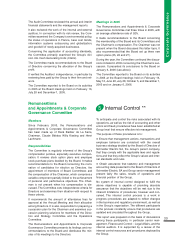APC 2005 Annual Report Download - page 42
Download and view the complete annual report
Please find page 42 of the 2005 APC annual report below. You can navigate through the pages in the report by either clicking on the pages listed below, or by using the keyword search tool below to find specific information within the annual report.
40
Internal Control Organization
Key participants
a) Board of Directors, Audit Committee and
Remunerations and Appointments & Corporate
Governance Committee
Article L.225-35 of the Commercial Code states that
the Board of Directors is responsible for determining
the Company's business strategy and overseeing its
implementation. In this oversight capacity, the Board of
Directors participates in Schneider Electric's system of
internal control.
The control exercised by the Board of Directors prima-
rily extends across the following areas:
Implementation of Group strategy. Under the
Board's internal rules limiting the powers of the Chief
Executive Officer, the prior approval of the Board is
required for all material acquisitions, disposals and
commitments (defined as transactions in excess of
100 million).
The annual and interim financial statements, which
are approved or reviewed by the Board of Directors.
Prior to their submission to the Board of Directors, the
financial statements are reviewed by the Audit Com-
mittee, which reports its conclusions to the Board. The
main purpose of the Audit Committee's review is to
obtain assurance as to whether the accounting poli-
cies used are appropriate and have been applied con-
sistently from one period to the next, whether transac-
tions that are material at Group level have been prop-
erly accounted for and whether the rules governing the
inclusion of companies in the scope of consolidation
have been properly applied.
The reliability of the internal control system. The
Audit Committee reports to the Board of Directors on
its review of the internal audit organization, programs
and findings, as well as on any examination of finan-
cial or accounting risk management issues performed
at the Committee's own initiative or at the request of
the Board of Directors or the Chairman.
The Remunerations and Appointments & Corporate
Governance Committee makes recommendations to
the Board of Directors concerning the Chairman and
Chief Executive Officer's compensation package and
on management stock option plans. The Committee
also reports to the Board about senior management
compensation policies applied within the Group.
b) Senior Management
Group senior management is organized around the
Direction and Strategy Committee and the Operations
Committee.
The Direction and Strategy Committee comprises
Henri Lachmann, Chairman and Chief Executive Offi-
cer, Jean-Pascal Tricoire, Chief Operating Officer, and
the Executive Vice-Presidents in charge of the Corpo-
rate Functions (Finance & Control - Legal Affairs,
Human Resources & Communication and Strategic
Deployment).
The Direction and Strategy Committee regularly
reviews the development outlook of the Group's core
businesses, opportunities for bolt-on acquisitions and
the business case for divestments. It reviews the
Group's overall strategies, its innovation, geographic
expansion and human resources policies and policies
governing relations with research and training estab-
lishments.
The Operations Committee is chaired by Jean-Pascal
Tricoire and comprises the Executive Vice-Presidents
of the North American, European, Asia-Pacific and
International & Iberian Operating Divisions, and the
Executive Vice-Presidents in charge of the three Cor-
porate Divisions (Customers & Markets, Products &
Technology and Globalization & Industry). The Execu-
tive Vice-Presidents in charge of Finance & Control -
Legal Affairs and Human Resources & Communica-
tion also attend Operations Committee meetings.
The line executives of growth platform acquisitions
also report to Jean-Pascal Tricoire.
The Operations Committee reviews the profit centers'
business and financial performance at each of its
meetings. It tracks progress on major projects to
improve IT management processes and deals with all
issues related to production management, supply
chain optimization and relations with partners and dis-
tributors. It performs ex-post reviews of product
launches and monitors technological advances that
are likely to be of interest to the Group.
c) Internal Audit
The Vice-President in charge of the 18-member Inter-
nal Audit Department reports to the Chairman and
CEO and to the Audit Committee.
The internal auditors are responsible for ensuring at
the level of each unit that:
Risks are appropriately identified and managed.
Significant financial, management and operating
information is accurate, reliable and timely.
Employees' actions are in compliance with the
Group's policies, standards, procedures and the appli-
cable laws and regulations.
Resources are acquired economically, used effi-
ciently and adequately protected.
The internal auditors carry out their work according to
an adjustable annual plan.
Internal audit plans are drawn up based on risk and
control concerns identified by management, taking
into account the results of past audits, the work per-
formed by the external Auditors and control self-
assessments by the units. When necessary, the audit
plan is adjusted during the year to include special
requests from senior management. In light of Schnei-
der Electric's core businesses, internal audit proce-
dures focus mainly on revenue recognition, cash and
asset management processes, wages and benefits,
financial reporting, information systems, manufactur-
ing operations, purchasing and operating expenses.
The internal auditors also review newly acquired units
to assess their level of integration and ensure that
Group rules and guidelines are applied properly.
























